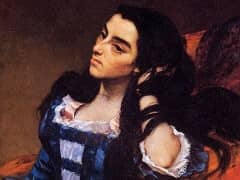The Woman in a Podoscaphe, 1865 by Gustave Courbet

By 1865, the first summer that Courbet spent at Trouville, the harbor town and its close neighbor Deauville had become fashionable resorts for a Parisian and international clientele. Strolling and picnicking on the sands and even bathing in the sea had become stylish pastimes during the Second Empire; this was the life documented in the beach scenes by Courbet's older colleague Eugene Boudin. Sea bathing was still rather a decorous activity, however, and therefore the artist (and others) were much struck by the spectacle of a young woman who went out into the waves by herself, clothed only in a simple sleeveless shift and with her long hair blowing in the wind, propelling a kind of catamaran structure she called a "podoscafe." Courbet referred to her as the Amphitrite moderne, and set about making a large painting of her. Though it was never shown at the Salon, the ambitious scale of the work leads one to believe that it was originally conceived as a Salon painting. It was characteristic of Courbet to seize upon such a subject, unmistakably modern yet with classical overtones: a modern Venus not rising from the sea but dominating it. It is even possible that he might have initially conceived the painting as a kind of challenge or reproof to the trite pandering of Cabanel's Birth of Venus, shown at the Salon of 1863.
This female figure is certainly not presented in terms of sexual passivity, but of independence and prowess. She fills the pictorial field, brought as close to the viewer as she can be without having her interesting vessel and her long, double-ended oar cut off by the edge of the painting. Her position on the structure is easy and confident. (Doubtless, it was quite impossible in actual fact without a harness of some kind, but she posed for him on land and Courbet was not concerned with literalism.) The loose, flowing hair, always so attractive to Courbet, was at the time a conventional signal of sexual availability, but seems here rather to rhyme with the waves through which this sea nymph plies her craft. The surface of the painting was not completely finished, and this fact together with restorations undergone sometime in this century, contributes to the unusual flatness of the figure. Nonetheless her conception and her placement in the vast space of the sea make this an unforgettable image, one that only Courbet would have had the bold naivete to create.















